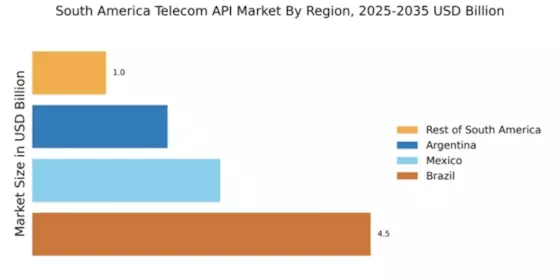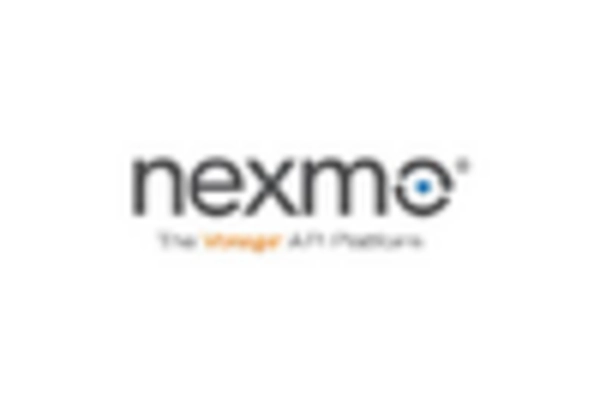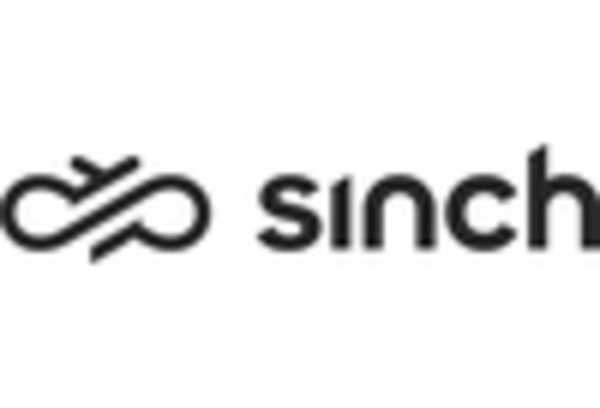Emergence of 5G Technology
The advent of 5G technology is poised to revolutionize the telecom API market in South America. With the rollout of 5G networks, expected to cover over 50% of the region by 2027, the demand for telecom APIs that can leverage the enhanced capabilities of 5G is likely to increase. This technology enables faster data transmission, lower latency, and greater connectivity, which in turn opens up new possibilities for applications in sectors such as smart cities, autonomous vehicles, and augmented reality. The telecom API market is well-positioned to capitalize on these advancements, as developers seek to create innovative solutions that harness the power of 5G. The potential for growth in this area is substantial, as businesses and consumers alike embrace the benefits of next-generation connectivity.
Expansion of IoT Applications
The proliferation of Internet of Things (IoT) applications significantly influences the telecom API market in South America. With an estimated 30% growth in IoT device adoption expected by 2027, telecom APIs play a crucial role in enabling connectivity and data exchange among these devices. Industries such as agriculture, transportation, and healthcare are increasingly leveraging IoT solutions to optimize operations and enhance efficiency. Telecom APIs facilitate the integration of IoT devices with existing systems, allowing for real-time data processing and analytics. This trend not only drives innovation but also creates new revenue streams for telecom operators. The telecom API market is thus poised to benefit from the expanding IoT ecosystem, as businesses seek reliable and scalable solutions to support their IoT initiatives.
Rising Demand for Mobile Connectivity
The telecom API market in South America experiences a notable surge in demand for mobile connectivity. As mobile penetration rates reach approximately 80% across the region, the need for seamless communication solutions becomes increasingly critical. This demand is driven by the growing reliance on mobile applications for various services, including banking, e-commerce, and social networking. Telecom APIs facilitate the integration of these services, enabling businesses to enhance their offerings and improve user engagement. Furthermore, the increasing number of mobile subscribers, projected to exceed 400 million by 2026, indicates a robust market potential for telecom API providers. The telecom API market is thus positioned to capitalize on this trend, providing essential tools for developers and businesses to create innovative mobile solutions.
Growing Focus on Data Privacy and Security
The telecom API market in South America is increasingly shaped by a growing focus on data privacy and security. With the implementation of stricter data protection regulations, businesses are compelled to adopt solutions that ensure compliance and safeguard customer information. The telecom API market is responding to this demand by offering APIs that incorporate robust security features, such as encryption and authentication protocols. As organizations prioritize data protection, the market for secure telecom APIs is expected to expand, with a projected growth rate of 15% annually. This trend not only enhances consumer trust but also positions telecom API providers as essential partners in navigating the complex landscape of data privacy regulations.
Increased Investment in Digital Transformation
The telecom API market in South America is witnessing a surge in investment aimed at digital transformation initiatives. As businesses across various sectors recognize the importance of digitalization, the demand for telecom APIs that support these efforts is on the rise. In 2025, it is estimated that digital transformation spending in the region will reach approximately $50 billion, with a significant portion allocated to telecom solutions. This investment is driven by the need for enhanced operational efficiency, improved customer engagement, and the ability to adapt to changing market dynamics. The telecom API market stands to gain from this trend, as companies seek to integrate advanced technologies such as artificial intelligence and machine learning into their operations, thereby enhancing their competitive edge.


















Leave a Comment